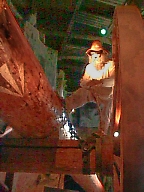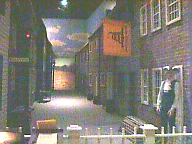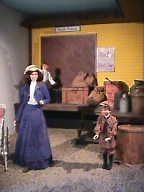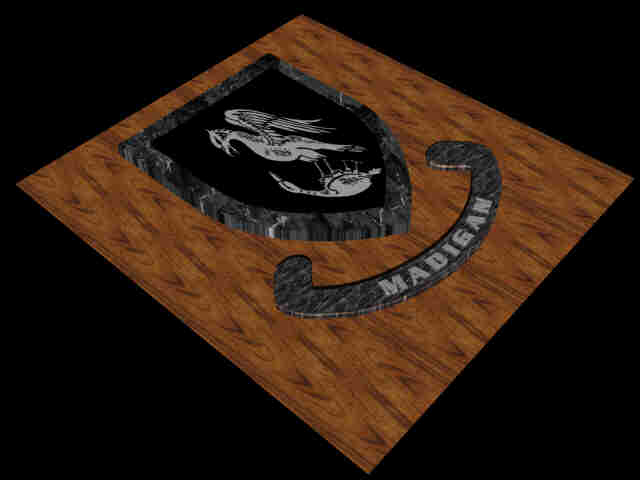Here we met
Denys Draper, a woodsman who talks about moving away from the sea
coast and living with the native Americans. He also talked about
the mast  tree harvest which was done by
England during this time. Trees with a diameter of greater then
24 inches were marked with an arrow to proclaim them to be owned
by the King of England destined to be cut and sent back to
England to be turned into the masts of ships. It became a bone of
contention to the locals and the beginning of unrest among the
colonists. We moved on to the next scene which was of a farmer
who had taken advantage of the government's offer of 100 acre
land grant if he would settle and
tree harvest which was done by
England during this time. Trees with a diameter of greater then
24 inches were marked with an arrow to proclaim them to be owned
by the King of England destined to be cut and sent back to
England to be turned into the masts of ships. It became a bone of
contention to the locals and the beginning of unrest among the
colonists. We moved on to the next scene which was of a farmer
who had taken advantage of the government's offer of 100 acre
land grant if he would settle and develop the land. We then arrived at
a winter scene showing living conditions for the early settlers.
Amazingly the room was quite cool due to a cooling unit that
created two frozen areas on either side of the walkway. Running
our hands over the ice as we walked to the cabin, gave us a
definite feeling for the harsh winters that were endured here. As
the trail and time continued we found ourselves in a board barn
in the early 1700s.
develop the land. We then arrived at
a winter scene showing living conditions for the early settlers.
Amazingly the room was quite cool due to a cooling unit that
created two frozen areas on either side of the walkway. Running
our hands over the ice as we walked to the cabin, gave us a
definite feeling for the harsh winters that were endured here. As
the trail and time continued we found ourselves in a board barn
in the early 1700s.  Here mannequins showed the labors of
the trades practiced during that period. On we went to the boat
shop, which represents the Portsmouth Navel Shipyard where the
Reliance and the Ranger were built. These were the first two war
ships of the Continental Congress with the Ranger being Captained
by John Paul Jones. The next scene is of Portsmouth in 1777
during
Here mannequins showed the labors of
the trades practiced during that period. On we went to the boat
shop, which represents the Portsmouth Navel Shipyard where the
Reliance and the Ranger were built. These were the first two war
ships of the Continental Congress with the Ranger being Captained
by John Paul Jones. The next scene is of Portsmouth in 1777
during  the American Revolution. A long street leads away
where a short film shows the men leaving for the battle of Bunker
Hill. A lady talks to the visitors about life in Portsmouth,
where the printing shop was located. Here we met 77 year old
David Moreton, a printer of the New Hampshire Gazette, who was
busy printing copies of the U. S. Constitution on an old hand
printing press which actually worked. He was not so busy as to
not be able to take time out to fold continental hats for a
couple
the American Revolution. A long street leads away
where a short film shows the men leaving for the battle of Bunker
Hill. A lady talks to the visitors about life in Portsmouth,
where the printing shop was located. Here we met 77 year old
David Moreton, a printer of the New Hampshire Gazette, who was
busy printing copies of the U. S. Constitution on an old hand
printing press which actually worked. He was not so busy as to
not be able to take time out to fold continental hats for a
couple  of kids who watched in fascination.
We continued on into a room set in October 29, 1789 and watched
George Washington deliver his thank you address as he did in
Portsmouth on that date. We moved on down the trail and into the
1800s. We passed through the Abbott Downing Co. which built
carriages in the 1830s including the famous stage coaches of the
Old west era. We then arrived in a typical New Hampshire town
square where Daniel Webster was delivering a dissertation on the
life and times he lived in. The face of Daniel is back projected
giving the mannequin a life-like appearance.
of kids who watched in fascination.
We continued on into a room set in October 29, 1789 and watched
George Washington deliver his thank you address as he did in
Portsmouth on that date. We moved on down the trail and into the
1800s. We passed through the Abbott Downing Co. which built
carriages in the 1830s including the famous stage coaches of the
Old west era. We then arrived in a typical New Hampshire town
square where Daniel Webster was delivering a dissertation on the
life and times he lived in. The face of Daniel is back projected
giving the mannequin a life-like appearance. On we
went, passing a 1850 farm kitchen, and a town meeting where the
elected were discussing whether or not to allow square dancing in
the town hall. The path continues through an 1803 barn that was
moved to the site, and on to many other scenes until arriving at
the grand hotel where we waited for the
On we
went, passing a 1850 farm kitchen, and a town meeting where the
elected were discussing whether or not to allow square dancing in
the town hall. The path continues through an 1803 barn that was
moved to the site, and on to many other scenes until arriving at
the grand hotel where we waited for the  conductor to take us on the train. We
entered a passenger car and took a seat. A beautiful fall scene
filled both side outside the train. There was a sharp whistle and
a shudder and the train jerked and lurched and the scene outside
began to slip by. The ride was all mechanical and quite real
feeling. It made a very impressive ending for a most interesting
walk through New Hampshire and time. On the outside, as we looked
over the building, I couldn't pass up an opportunity to lock up
my valuables so to speak (:-)
conductor to take us on the train. We
entered a passenger car and took a seat. A beautiful fall scene
filled both side outside the train. There was a sharp whistle and
a shudder and the train jerked and lurched and the scene outside
began to slip by. The ride was all mechanical and quite real
feeling. It made a very impressive ending for a most interesting
walk through New Hampshire and time. On the outside, as we looked
over the building, I couldn't pass up an opportunity to lock up
my valuables so to speak (:-)
*** THE END ***

